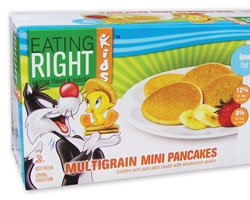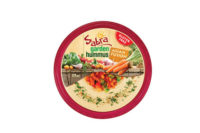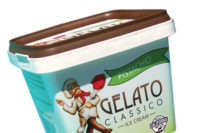Don’t Buck Privates

PLMA’s Viva Latino pavilion featured products reflecting Latino and Hispanic traditions, tastes and preferences. Displays of store-brand food and non-food products featured products from Walmart, Target, Publix, Aldi, Winn-Dixie, Smart & Final, Navarro and Fiesta, some of whom have added their own dedicated Hispanic brands: Arrera (Walmart Mexico), Casa Mamita and Benita (Aldi), Montecito (Smart & Final) and Vida Mia (Navarro).
However, the trend was not limited to the pavilion; the show floor featured such Hispanic-influenced products as Fire Roasted Morita Chili Ranch Sauce, Chipotle Chili Aiolo, Argentinean Fresh Sausage and Corn Buns with Jalapeno. Nor was the notion of ethnic foods limited to Hispanic flavors. Tastemorr Snacks announced a new 8oz. size version of its Pita Chips.
While store brands may have long been regarded as knock-offs of established national brands, private label manufacturers are innovating in their own right. Delivering the keynote address to attendees, Douglas Merrill, chief information officer and vice president of engineering at Google until 2008, explored how companies can embrace a culture that appreciates change and engagement with consumers as means to innovate successful new products and services. He acknowledged, “Sometimes, it’s ugly and painful; your customer wants to engage with you,” but “ultimately, it will affect sales. . . Companies don’t innovate to innovate, they innovate to win.”
A 2011 study by GfK/Roper for PLMA finds consumers are responding to private-label manufacturers’ innovative efforts. In fact, the percentage of consumers who judge private label to be “equal to or better than” national brands rose to 80%, up from 77% in 2009. Furthermore, half of consumers believe the supermarket or grocery store’s private label products they now buy have been “improving.” The percentage who say store brands have improved either “greatly” or “somewhat” as compared to a few years ago is up to 49%, a 10-point rise since 2009.
An uptick in sales for private label products has accompanied the perceived improvements. One-third of those surveyed report they are buying more private label products now than compared to a year ago. The “buying more” response has steadily increased: It was 22% in a 2006 Ipsos Mori survey and 30% in GfK surveys in 2008 and 2009. More than half say they buy the supermarket or grocery store’s store brand products “frequently” when they do the main household shopping, a response that has exceeded 50% the past few years.
In a separate 2011 study by Mintel, American shoppers also appear to believe store brand quality has improved. Some 44% of grocery shoppers believe private label products are of better quality today than five years ago, and 39% would recommend a store brand product. One third said they do not feel they are sacrificing anything (such as flavor or prestige) by using store brands, while 19% believe it is “worth paying more for name-brand products.”
Added Mintel, “The lack of perceived difference can be attributed, in part, to the fact that many retailers have introduced premium private label products that rival their branded counterparts in flavor and nutritional value, as well as the packaging design and shelf placement.”
According to the most recent PLMA statistics, in supermarkets, sales of store brands increased by over 2%, and in drug chains they were up about 5%. In each of these two mainstream channels, private label dollar share, a key indicator, rose to an all-time high. Over the past decade, annual sales of private label products have increased by 40% in supermarkets and by 96% in drug chains.
Overall private label sales amount to roughly $88.5 billion, with store brands now accounting for almost one out of every four items sold in the country’s supermarkets, drug chains and discount stores, according to The Nielsen Company. PLMA contends an even more accurate sales figure for all private label food and non-food grocery sales in the U.S. would be far higher. “There was an estimated $15 to $20 billion in private label sales in channels that are not traditionally counted, such as warehouse clubs, limited assortment/box stores, convenience stores and dollar stores, producing a grand total that exceeded $100 billion during 2010,” explains a PLMA release, which estimates cold-case and freezer private-label sales at “several billion dollars” annually.
Private labels’ influence extends far beyond finished foods, however. According to Packaged Facts' report “Fats and Oils,” sales of private label fat/oil products will reach $1.6 billion this year, with sales of private-label fats/oils growing by 5.3%, compared to overall category growth of 0.6%, in the 52 weeks ending April 17 in mass-market channels (excluding Walmart), according to SymphonIRI data. Most of this growth was in butter, which enjoyed sales increases of 19% during the time, to account for more than half of all butter sales. Packaged Facts stated this market share could be the result of larger increases in butter prices, which may have led many consumers to switch to store brands.
In olive oil, however, the decline in price has done nothing to hamper the segment’s private label products. Sales of private label olive oils were up 3%.
While the recession may have compelled consumers to try generally less-expensive private-label products, the quality of those products has led many of those same consumers to stick with them. As Consumer Edge Research notes, “The recent recession drove more households to try private label, and for those categories where the satisfaction is high, consumers are saying ‘I like the performance and don't need to rush back to the branded offering I was using before.’” However, the economy is not the only driver of store brands’ recent success, which Consumer Edge believes will continue well into the future. “The economy is only one factor. If we look back five or 10 years ago, there’s been a long-term upward trend in household penetration for private label across the CPG space. Retailers’ investment in upgraded product quality along with additional merchandising and space are also contributing to store brand growth.”
From the October 28, 2011, Prepared Foods’ E-diiton
Looking for a reprint of this article?
From high-res PDFs to custom plaques, order your copy today!







